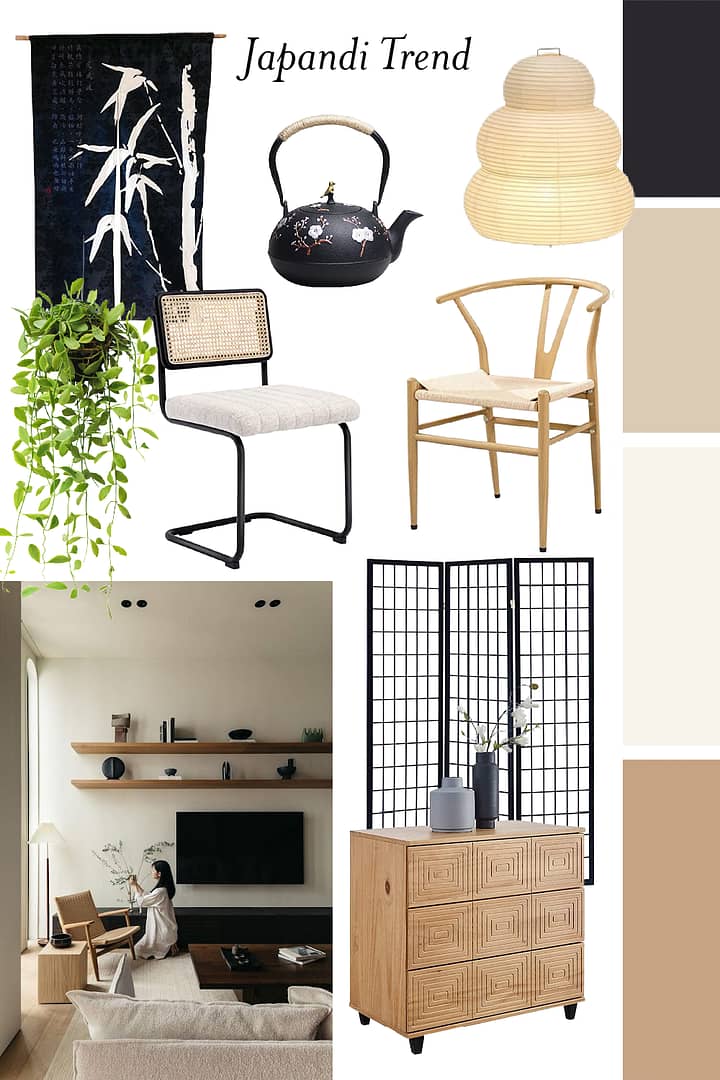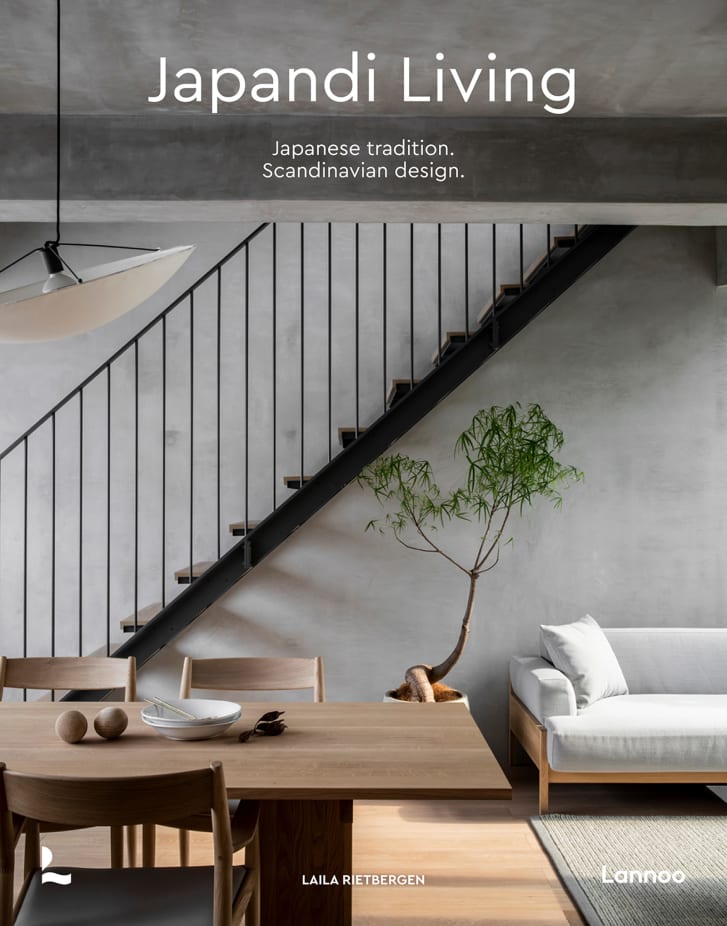Last Updated on November 30, 2022 by SampleBoard
The Japandi trend has gained popularity in recent years—it was first mentioned in our blog back in 2017—as more and more people are looking to create a calming, minimalistic space in their homes.
"Japandi" is a portmanteau of "Japanese" and "Scandi," representing a design style that blends elements of both Japanese and Scandinavian aesthetics.
This fusion creates a harmonious and balanced approach to interior design.
Combining the simplicity and functionality of Scandinavian design with the elegance and minimalism of Japanese design.
The goal is to create a serene, clutter-free space that is both visually appealing and practical.
Incorporating natural materials and neutral colors and focusing on craftsmanship and functionality.
The term "Japandi" has been used to describe this hybrid design trend that seeks to balance the best of both worlds from Japanese and Scandinavian design philosophies.
This style is perfect for small spaces since it doesn't require a lot of furniture or decor. Japandi style also has a calming effect, which can be helpful if you live in a busy city.
If you want to create a more serene and Zen space, Japandi style is definitely for you!

*Disclosure: I only recommend products I would use myself and all opinions expressed here are our own. This post may contain affiliate links that at no additional cost to you, I may earn a small commission.
Japandi's design aims to create a harmonious space that feels like an extension of nature.
You can create your oasis by keeping the space uncluttered and using natural materials.
Regarding furniture, Japandi interiors typically feature low-profile pieces with clean lines.
Scandinavian furniture is often made of natural materials like wood or stone, which complement the Japanese elements of the design.
Japandi furnishings are typically functional and understated, focusing on quality craftsmanship.
Furniture is kept to a minimum in Japandi interior design. The focus is on quality over quantity, pieces are carefully curated and placed with purpose.
Every item has a function and serves a purpose in the overall design.

Color is another crucial element of Japandi design.
The palette is typically muted and calming, with earth tones predominating.
Black and white are also commonly used in Japandi interiors.
Natural materials like wood and stone are often left in their natural state, adding texture and visual interest to the space.

Laila Rietbergen, the author of the new book "Japandi Living", is a leading expert on the Japandi lifestyle.
In her book, she explores the origins of this unique style and how to incorporate it into your own life.
Drawing on her experiences living in Japan and Scandinavia, Rietbergen provides readers with beautiful photography and a detailed guide to creating a Japandi-style home.
While providing tips on how to blend these two distinct styles to create a harmonious and stylish home.
Whether you're looking for ways to add more Zen to your space or simply want to declutter and simplify your life, this book is a must-read.
Her beautiful Instagram page is also a must-visit: @japandi.interior

Wabi-sabi and Japandi, though both rooted in Japanese design philosophies, exhibit distinct characteristics that set them apart.
Wabi-sabi, a profound Japanese aesthetic, embraces the beauty of imperfection, transience, and the natural course of time.
It celebrates simplicity, modesty, and a deep connection to nature, where worn and weathered objects tell stories of their existence.
In contrast, Japandi is a contemporary design style that merges Japanese and Scandinavian principles.
While Japandi may incorporate elements of wabi-sabi, its primary focus lies in achieving a harmonious balance between the functional minimalism of Scandinavian design and the elegant simplicity of Japanese aesthetics.
Japandi emphasizes clean lines, a neutral color palette, and practicality.
Creating a modern and serene space that reflects the best of both cultural influences without necessarily delving into the profound philosophical aspects of wabi-sabi.
In Japan, wabi-sabi is an aesthetic centered around accepting transience and imperfection.
The philosophy values simplicity and rustic beauty and finds joy in the patina of age. Wabi-sabi design is a great way to bring a sense of calm and grounding to your home.
By embracing natural materials, neutral colors, and organic forms, you can create a tranquil and safe space.

The Japandi color palette plays a pivotal role in achieving this design style's serene and harmonious atmosphere.
Rooted in the minimalist principles of both Japanese and Scandinavian aesthetics. The color scheme is deliberately restrained, emphasizing a refined elegance.
The Japandi color palette focuses on neutrals, with hues like white, cream, taupe, and various shades of gray dominating the visual landscape.
White serves as a foundational backdrop, imparting a sense of purity and airiness to the space.
Cream and taupe introduce warm undertones, creating a cozy and inviting ambiance.
These neutral tones are often employed on larger surfaces such as walls and major furniture pieces, establishing a calming backdrop that allows other design elements to shine.
Shades of gray, ranging from soft and light to deeper, muted tones, add sophistication and depth to the palette.
Gray's versatility complements the overall design's simplicity, creating a nuanced visual experience without overwhelming the space.
This careful selection of neutral colors in the Japandi style not only fosters a serene environment.
But also allows for integrating natural materials and textures to play a more prominent role.
Further, the interior space should be connected to the principles of nature and simplicity that define Japandi design.
The resulting color palette is timeless and elegant, effortlessly achieving the balanced, calming aesthetic characteristic of Japandi interiors.


Japandi design heavily emphasizes the use of natural materials. So, incorporate plenty of wood, bamboo, stone, and paper into your decor.


One of the most important aspects of the Japandi style is minimalism, so avoid going overboard with your decorating.
Stick to a few key pieces that will significantly impact without overwhelming the space.
Another key element of Japandi design is creating a sense of harmony between the different elements in the room.
This can be achieved by using similar colors and textures throughout the space.


Regarding furniture and accessories, stick to clean lines and simple silhouettes.
This will help to create a more calm and serene atmosphere in your home.
One of the best ways to achieve a Japandi look is by incorporating nature into your design scheme.


Japandi design is about creating a tranquil environment promoting relaxation and mindfulness.
By blending the best of Japanese and Scandinavian design principles, Japandi interior design creates a unique and beautiful aesthetic perfect for any home.
A Japandi living room effortlessly merges the simplicity of Scandinavian design with the timeless elegance of Japanese aesthetics, creating a harmonious and balanced space.
A Japandi living room is characterized by clean lines, muted color palettes, and a focus on natural materials. It exudes tranquility and warmth.
The furniture tends to be minimalist, with functional pieces crafted from light-toned woods, such as oak or ash.
Incorporating elements of Japanese minimalism, the space often features low-profile furniture and simple, serene decor.
Neutral hues dominate the color scheme, while occasional pops of muted colors inspired by nature add visual interest.
Natural textures like bamboo, rattan, and stone enhance the tactile experience, creating a sense of calm and connection to the outdoors.
Japandi living rooms often embrace the concept of "wabi-sabi," finding beauty in imperfection and carefully curated decorative items.
Like traditional Japanese pottery or Scandinavian textiles, complete the look.
The result is a sophisticated, comfortable living area embodying Japanese and Scandinavian design philosophies.
A Japandi bedroom is a serene sanctuary that seamlessly fuses the minimalist elegance of Japanese design with the cozy simplicity of Scandinavian aesthetics.
Creating a harmonious atmosphere for rest and rejuvenation.
This style emphasizes clean lines, uncluttered spaces, and a neutral palette.
Often featuring a soothing combination of muted tones like soft grays, whites, and natural wood hues.
The furniture in a Japandi bedroom is simple and functional, with low-profile bed frames and practical storage solutions.
Japanese design principles, such as the appreciation for nature and the concept of "ma" or negative space, are evident in the room's layout, fostering a sense of tranquility.
Natural materials like light-toned wood, bamboo, and linen contribute to the tactile warmth of the space.
Minimalist decor choices add the finishing touches, such as shoji screens, simple artwork, and carefully selected potted plants.
Creating a Japandi bedroom that exudes sophistication and calmness provides an ideal retreat for relaxation and rest.
A Japandi kitchen blends the simplicity of Japanese design with the cozy, functional elements of Scandinavian aesthetics, resulting in a harmonious and serene culinary space.
Minimalistic Design: Japandi kitchens embrace simplicity and minimalism. Clean lines and clutter-free surfaces contribute to an uncluttered and calming environment.
Neutral Color Palette: A muted and neutral color scheme is prevalent, often featuring a combination of soft whites, grays, and natural wood tones. This palette creates a sense of tranquility and simplicity.
Natural Materials: Japandi design hallmarks include the use of natural materials, such as light-colored woods like oak or ash, bamboo, and stone. These materials add warmth and a connection to nature.
Functional Furniture: Functional and streamlined furniture emphasizes practicality. Built-in storage solutions, minimalist cabinets, and open shelving contribute to an organized and efficient kitchen layout.
A Mix of Textures: Japandi kitchens incorporate a mix of textures to add visual interest. Smooth surfaces, such as sleek countertops, can be juxtaposed with textured elements such as woven baskets, pottery, or natural fiber rugs.
Balance of Warmth and Coolness: The design balances the Scandinavian style's warm, inviting elements and the remarkable, zen-like aspects of Japanese design. This creates a comfortable and inviting cooking and dining space.
Unobtrusive Decor: Decorative elements are kept to a minimum, focusing on a few carefully chosen items with aesthetic and functional value. This might include handmade ceramics, simple pendant lights, or subtle artwork.
Connection to Nature: Japandi kitchens often incorporate indoor plants or herbs, bringing a touch of nature into the space. Large windows and natural light further enhance the connection to the outdoors.
Efficient Lighting: Thoughtful lighting design is essential. Natural light is maximized during the day, and pendant lights or under-cabinet lighting may create a warm and inviting atmosphere in the evenings.
Timeless Design Elements: Japandi kitchens prioritize timeless design over trendy elements. This ensures that the kitchen remains aesthetically pleasing and relevant for years.